WORKING PAPER 1: Fishing and natural resources in 18th-century Danish West Indies
By Johanne Buus Mosegaard, 11 June 2021
In this working paper, Johanne Buus Mosegaard (IN THE SAME SEA intern, February-June 2021) dives into the topic of marine resource use in the 18th century Danish West Indies (now the US Virgin Islands). How did enslaved and free people sustain themselves in these over-exploited island environments?
On 14 August 1802, the enslaved young man, Francis Teleman, sat in court in Christiansted town in St. Croix, one of the islands in the Danish Caribbean. His owner, Francis De Lui, had accused Teleman of stealing his money, and therefore Teleman had to defend himself. The judge treated Teleman with suspicion because a witness had told the court that he often carried money on him which was unusual for a slave. When asked how he found money, Teleman explained that his owner had allowed him to go on fishing trips. He earned “a lot of money” from the sale of his catches, which he got to keep for himself. The court did not, it appears, take further notice of Teleman’s maritime activities. Three days later, Teleman was acquitted due to lack of evidence.
In sources relating to the Danish West Indies (now the US Virgin Islands), information about fish, and natural resources in general, trickle out from everywhere. In court cases, travel accounts, law codes, maps, and paintings, we see traces of how islanders struggled over and engaged with natural resources. Often, as in the transcript of the trial against Francis Teleman, natural resources are mentioned briefly and seldom figure as the author’s main focus. The scant, yet frequent, references to fish and natural resource engagement suggest that maritime activities were often considered so much part of the everyday that they did not need description or explanation. Teleman just went on fishing trips from time to time, when he was not working as a hairdresser for his master. He probably delivered the good fish and shells to his master, cooked some himself, and sold the rest.
In this blog post, natural resources and fishing will be the centre of attention, as I will explore how Danish West Indian islanders searched for and made use of marine resources. This includes a focus on the authorities’ efforts to control, maintain, and distribute natural resources in a society that was fully dependent on human inequality and slavery to maintain itself as a sugar-producing colony. Also, this blog aims to give a sense of how Caribbean islanders and authorities sustained themselves in fragile and at times over-exploited island environments.
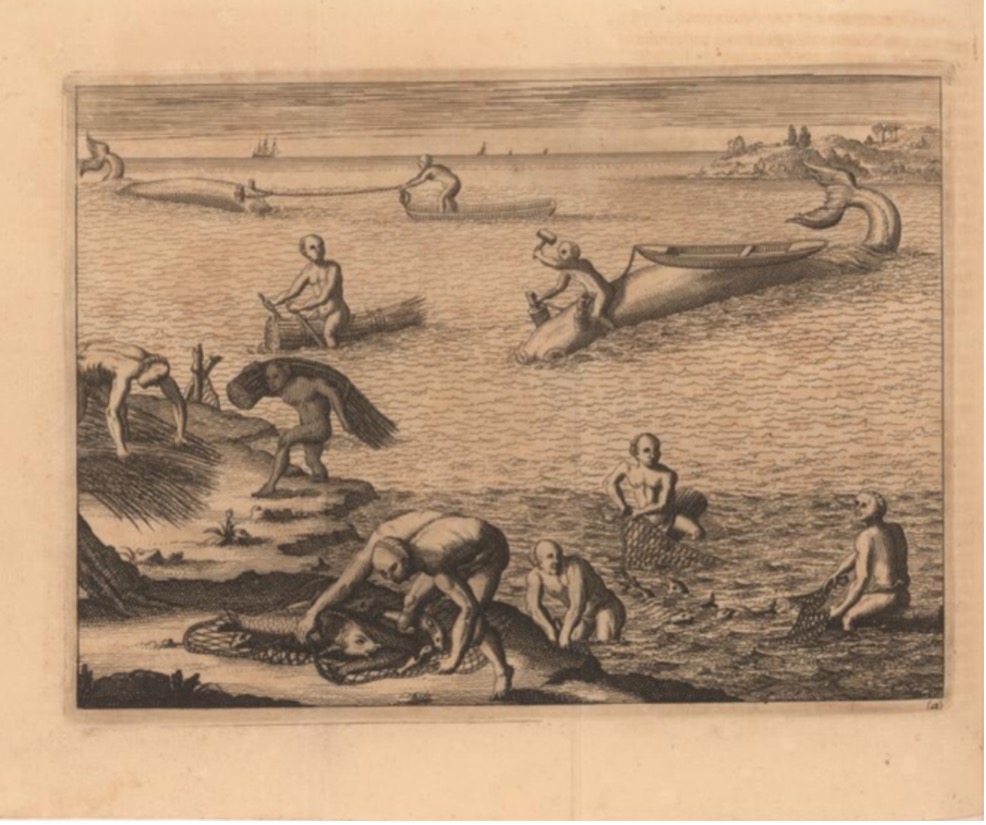
Danish West Indians engaged with marine resources in numerous ways in their everyday lives. It was mostly men who were employed as fishers, and who was responsible for providing marine resources, but it is likely that women collected seashells, crabs, and other edible marine animals that were found in shallow waters along the beaches.[1] These engagements took place from the very beginning of colonial settlement and were dependent on knowledge of what resources were edible, with what tools and remedies they could be caught, and how seaborn vessels could be constructed so they were suited to Caribbean waters.[2] Knowledge of traditional Amerindian ways combined with various traditions that both Europeans and Africans came with, made islanders capable of exploiting marine resources. This was crucial for the survival of the population, both free and enslaved.
The free population
The economic elite that owned or managed estates and slaves had the easiest access to and the most comfortable engagements with marine resources. Contemporary accounts include descriptions of planters holding “fish feasts” and how fish could be caught and consumed in abundance.[3] Members of the white elite would not fish themselves but would instead send slaves out to fish for them, as in the case of Francis Teleman. In an account from around 1740, often ascribed to the planter J. L. Carstens (1705-1747) yet authored by an unknown person presumably close to Carstens, it is stated that wealthy white islanders and some free people of colour made a living by owning fishing boats and having fishermen fish for them.[4] Also, according to the planter J. R. Haagensen (1711-1770), some people living on estates located near the shoreline in the town of Christiansted in St. Croix kept fish almost like livestock and had fishponds in their yards.[5] Indeed, some well-off islanders depended completely on fishing – like the white fisherman Bezaliel Daniel who in 1819 had three enslaved men fish for him – and some combined fishing with other economic activities, such as managing a plantation or having a job in the city.[6] Yet, the easy access that the Danish West Indian elites had to water resources was at times questioned. In an ordinance from 1786, Danish colonial authorities problematized that the wealthiest islanders were able to exploit marine resources to a greater extent than poor folks, because they could send more slaves to fish for them, hence exhausting one source of income for people of lesser means.[7]
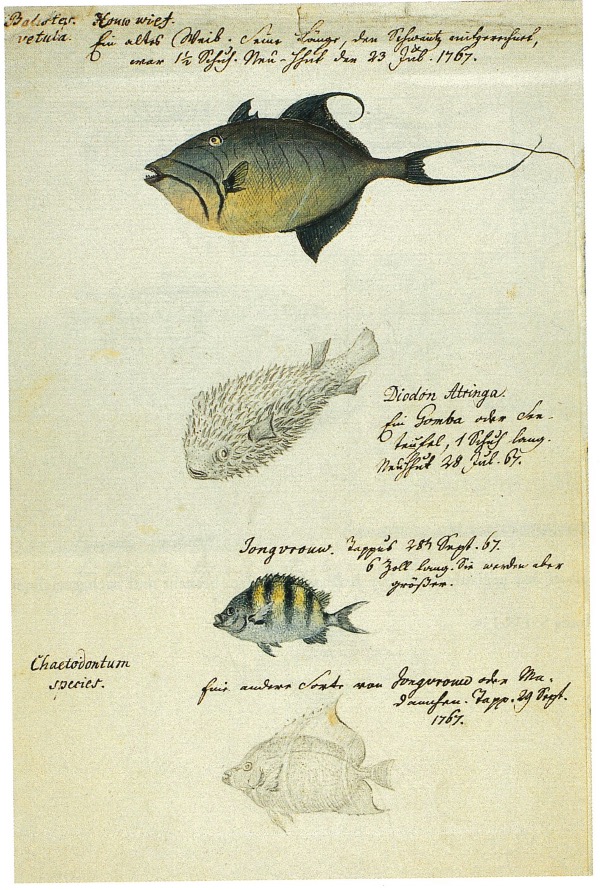
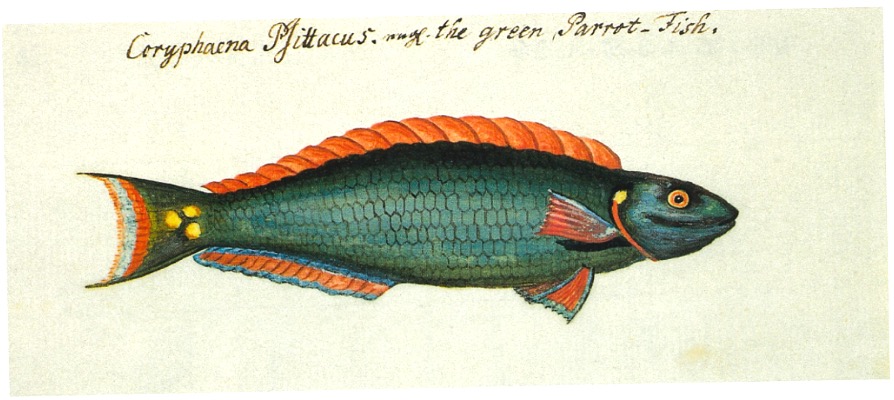
Detailed descriptions and drawings of marine resources fill the pages of accounts written by European settlers in the Caribbean. It was a way for them to establish themselves as authorities within the natural sciences, but it also gives evidence to the fact that marine resources were of major importance to islanders. C. G. A. Oldendorp, 1777, mixed material, in C. G. A. Oldendorp, Historie der Caribischen Inseln, Erster Teil, II, III.
Poor whites and free people of colour with limited means were in less privileged positions than the wealthy planters and other members of the economic elite in terms of both their engagements with and access to marine resources. As mentioned above, whites and presumably also a few free people of colour could make money on having enslaved men fish for them, but poor whites and poor free blacks were fishermen themselves, sometimes struggling to catch enough fish to make a living. This was the case for the white man Leonhard who made several efforts to establish a small fishing business but had to realize that he was not able to catch enough fish. Instead, he had to follow his fallback plan and walk between plantations, asking for work. According to the missionary C. G. A. Oldendorp (1721-1787), many poor whites supported themselves by fishing and turtling, as well as by transporting people and goods between islands in canoes. It is not entirely clear how well such marine activities sustained poor whites and freedmen. Oldendorp believed that poor whites were rather unsuccessful in their businesses and underlined this point by suggesting that they fed on “negro food.”[8] Indeed, both poor whites and freedmen were accused of stealing fishing tools from time to time.[9] In contrast, however, Haagensen noted that turtling had made “many poor men richer.”[10]
Poor whites and free people of colour suffered fewer restrictions and less control than did enslaved fishers. Hence, it was easier for them to establish an actual business. As noted, enslaved fishers often had to provide fish for their master and other people on their plantations. In contrast, poor whites and free people of colour could more easily orient their engagements toward the market. Some would act as independent entrepreneurs while others served under various types of contractual obligations. As such, it was perhaps easier for them to go on longer trips and to settle more or less temporarily on sparsely populated islands, on beaches where turtles nested, or close to waters rich in the catch. Turtles were desirable catches, as the delicate meat and rich eggs could be sold at good prices. Indeed, according to Oldendorp, both poor whites and freedmen made a living out of turtling. Though turtles could be found on the beaches of St. Croix as well as on St. Thomas, it would have been worthwhile taking longer trips to nearby islands and waterscapes to catch them.[11]
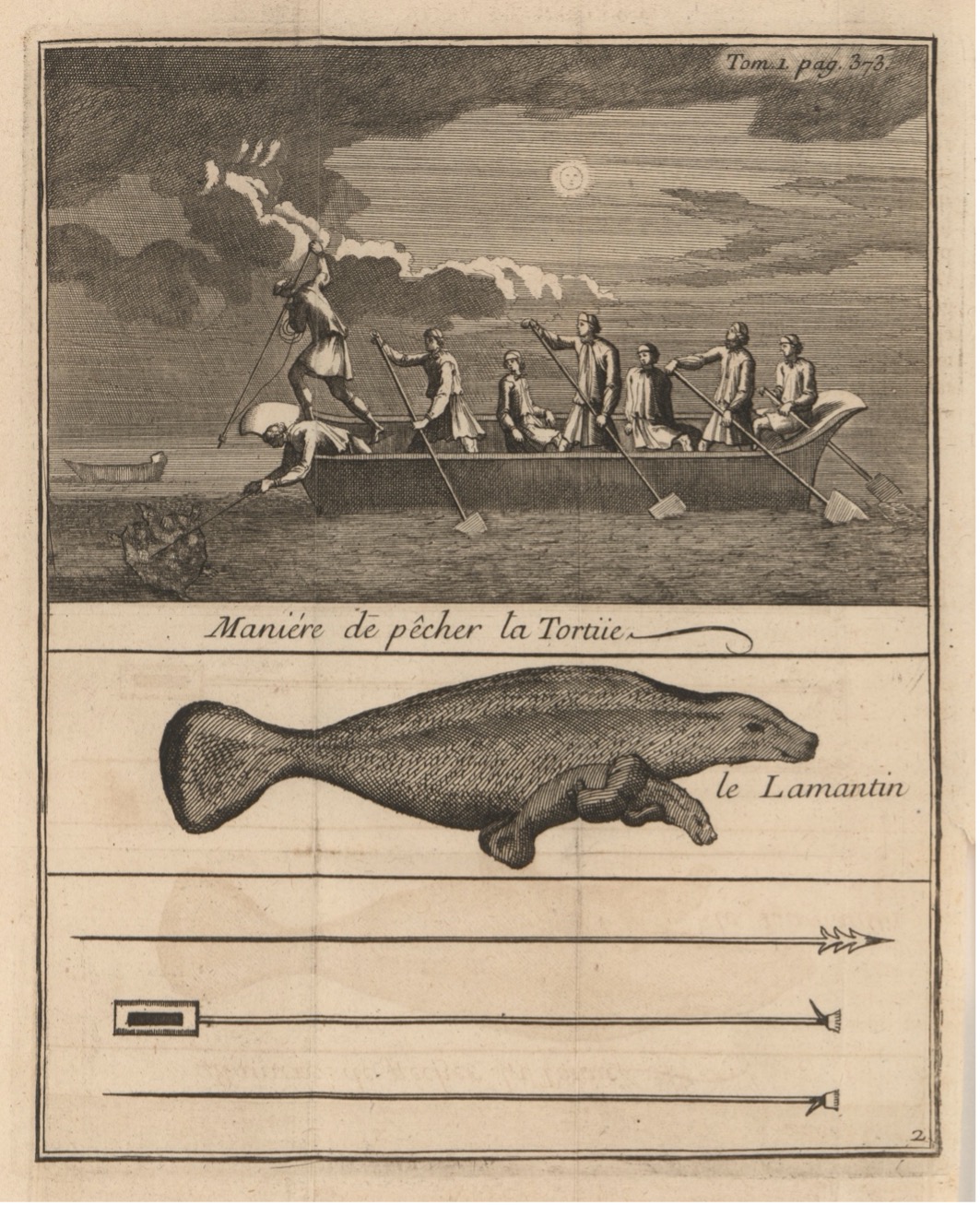
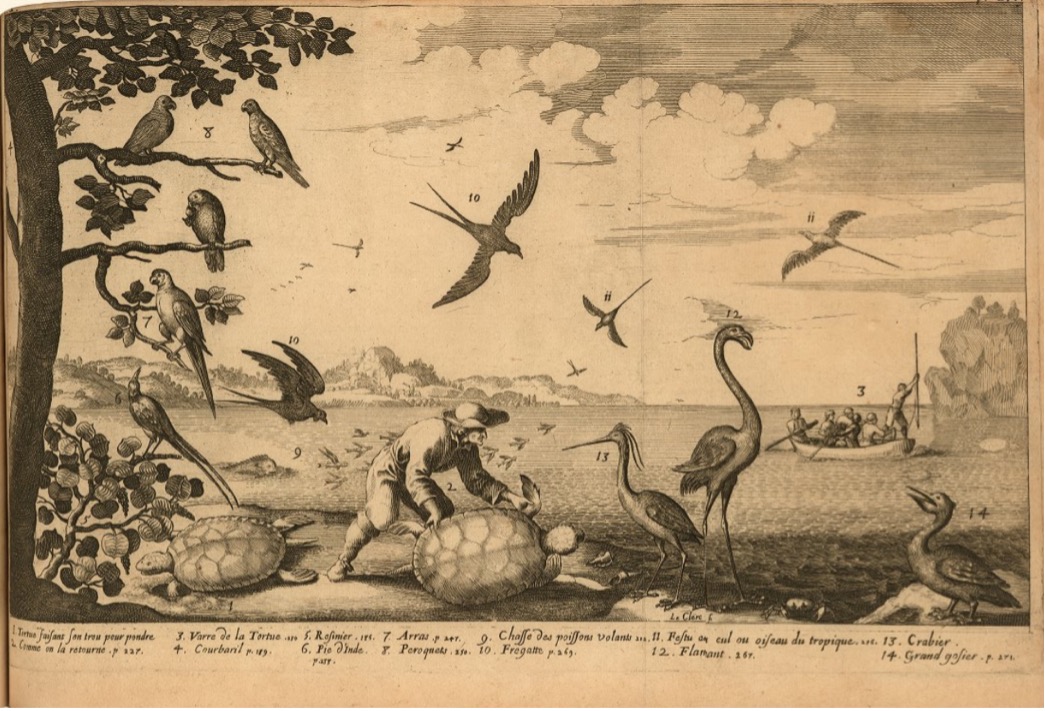
From the account attributed to Carstens, we know that the inhabitants of St. Thomas had an organized way of harvesting marine resources. On Crab Island, now Vieques, inhabitants of St. Thomas kept three or four small colonies for their fishermen, and from there, fish, turtles, crabs, and freshwater were shipped to the main island.[12] This was done in secret because the island was under Spanish control. Though it is not specified in Carstens’ account whether these fishermen were free or enslaved, it was generally easier for poor whites and free people of colour to participate in and establish organized, local foodways. No matter what, according to Søren Sommer (-1748), who served as overseer at one of the new estates on St. Croix and later became a planter himself, one could get fresh supplies of fish every day in the late 1730s.[13] Salted fish was also to be found on the markets, but it was primarily imported from outside of the Caribbean region.[14]
Colonial authorities tried to regulate the access that the different social groups had to natural resources. In a proclamation from 1728 for St. Thomas and St John, they announced that free people of colour were no longer allowed to make a living by fishing without being accompanied by or being in the service of a white man.[15] Perhaps this decree was an attempt to limit the possibilities that free people of colour had for establishing income-generating activities; perhaps it reflected a fear of the possible cooperation between free people of colour and slaves. According to councillor Georg Høst (1734-1794), who wrote an account of the Danish Caribbean possessions some 60 years after the proclamation was announced, islanders found the decree unreasonable. Whatever the case, it does not seem to have been enforced.[16] Still, the ordinance of 1728 testifies to the fact that black people were in a vulnerable legal position in the Danish West Indian society and that their subordinate position was also present in the fishing business. Thus, a white fisherman, Applegate, had a “mulatto” to work for him, but the opposite is hardly imaginable.[17] Though fishing was an example of an economic practice where blacks and whites cooperated, it was still on unequal terms.
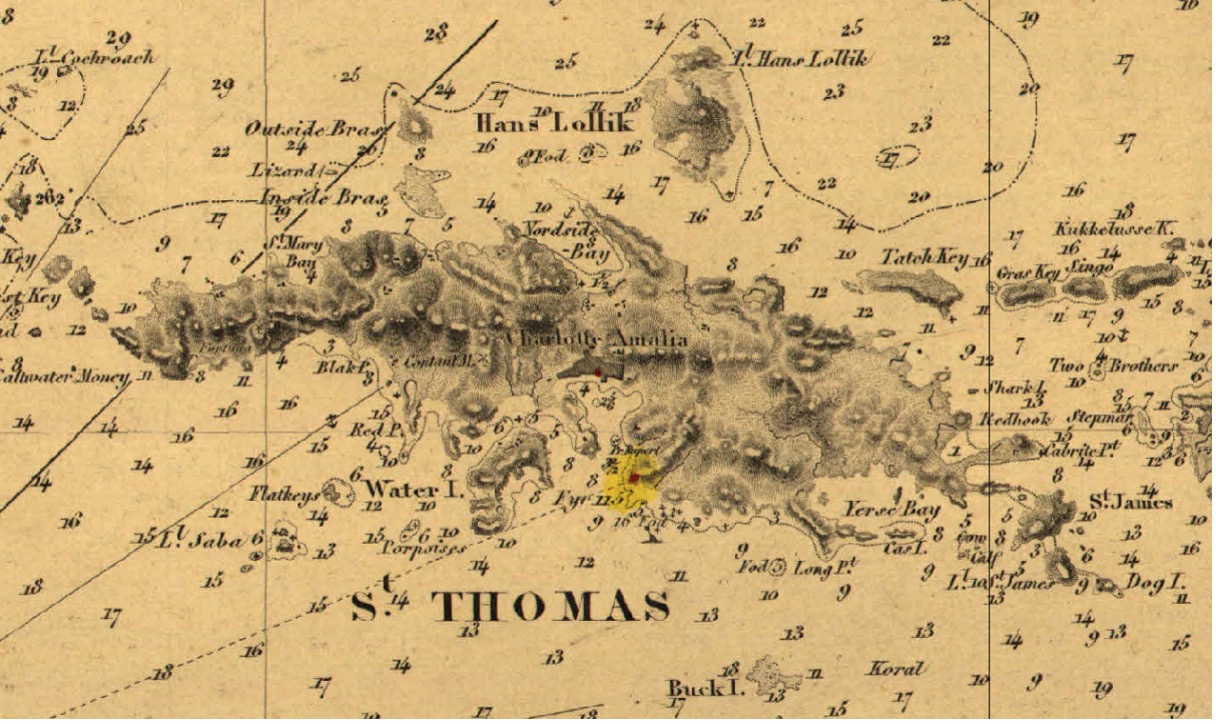
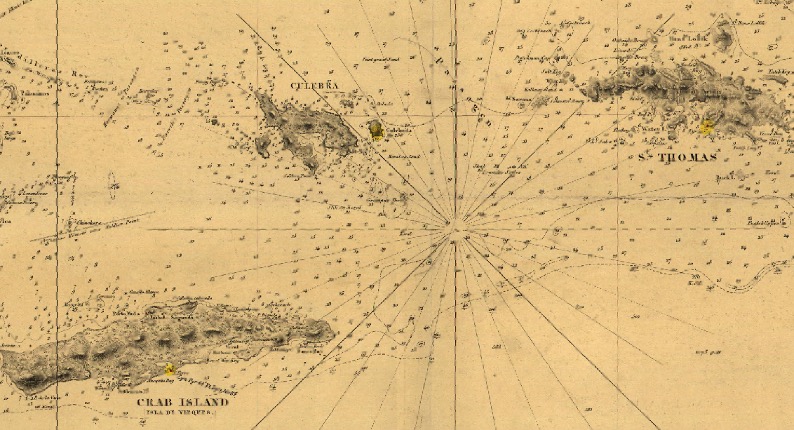
The enslaved population
The enslaved population did not only fish when they were ordered to by their masters, and they did not only fish for their masters. Marine resources were in fact a crucial part of enslaved people’s diet, as archaeological investigations show.[18] Enslaved people exploited marine resources in various ways. They splashed with poisonous wood in the waters to make the fish dizzy and easy to catch, they caught shells in the shallow waters along the shoreline, they paddled to deep waters in canoes to catch fish with nets, angles, spears, and harpoons, they caught lobsters by night, they attracted fish with lights and by clapping, and they collected oysters that lived on mangrove trees.[19] Some had as their main job to fish and were described in contemporary accounts as “fisher slaves,” some made fishing tools, and some combined marine activities with other tasks in order to secure survival.[20] When fishing for their masters, it is plausible that enslaved fishers took some for themselves, perhaps the smallest shells and trash fish.
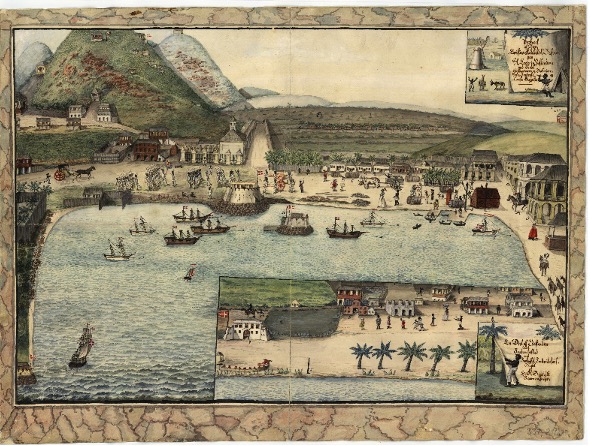
The waters outside of Christiansted on St. Croix were filled with various seaborn vessels. Many canoes, perhaps with fisher slaves, lie still near the shoreline. Henrik Gottfred Beenfeldt, 1815, watercolour on paper, Prospect af Byen Christianstad paa St. Croix, courtesy of the Danish National Archives.
In general, Danish colonial authorities were content with the islanders’ consumption of marine resources. In 1794, the Governor General of the Danish West Indies Ernst Frederich Walterstorff stated that a minimum of imported products was to be desired and that the Danish West Indies should instead “according to its nature, [blossom] with its own products.” According to him, the Danish islands were in a vulnerable position if they were too dependent on provisions from outside. But some fishing activities were still subject to regulation.[21] Rather than preventing the enslaved and other people from fishing, ordinances were issued to ensure that fish populations were not destroyed. It was both made illegal to fish with nets with small meshes and to fish with poison. The latter ordinance was in force from as early as 1700 and was repeated in 1771 and 1786.[22]
These ordinances attempted to regulate the actions of all groups of society, although Africans – especially the enslaved part – were subject to harsher punishment and more control. In 1786, it was temporarily made illegal to fish in the Great Pond, a shallow in-lake at the Eastend Quarter on St. Croix, because there was a lack of fish due to over-exploitation. If a white man broke the law, he would have to pay a fine of 20 rix-dollars, a free person of colour would be punished with 50 lashes at the yard of the captain of the Free Negro Company, while an enslaved person would be punished with the same number of lashes, but at the public whipping post. Furthermore, enslaved fishers had to carry on them a written fishing permit from their masters, and every white person was allowed to check them.[23]
In the late eighteenth century, it appears that authorities became increasingly aware that an open-access policy to natural resources was not sustainable, as they observed how the number of fish decreased. Sometimes it was temporarily, and sometimes it was for longer periods, like in 1771 when Governor General Peder Clausen described how “fishery on this island [of St. Croix] ha[d] decreased in the last couple of years.”[24] In 1786, Governor General Henrich Ludwig Ernst von Schimmelmann stated that it was “damaging and insulting to the public in general” when local foodways were threatened. Whether the enslaved population was included in this category of the public is doubtful.[25] Though enslaved and other people’s access to marine resources should be regulated and controlled, authorities sometimes encouraged slave masters to send out their slaves to fish. This happened after the 1772 hurricane when the authorities advised masters to send out every canoe to fish as much as possible for the “conservation” of all islanders.[26] This measure was of course necessary to survive the destructions caused by the hurricane, but it was also in line with the aim of the authorities to be as self-sufficient a society as possible.
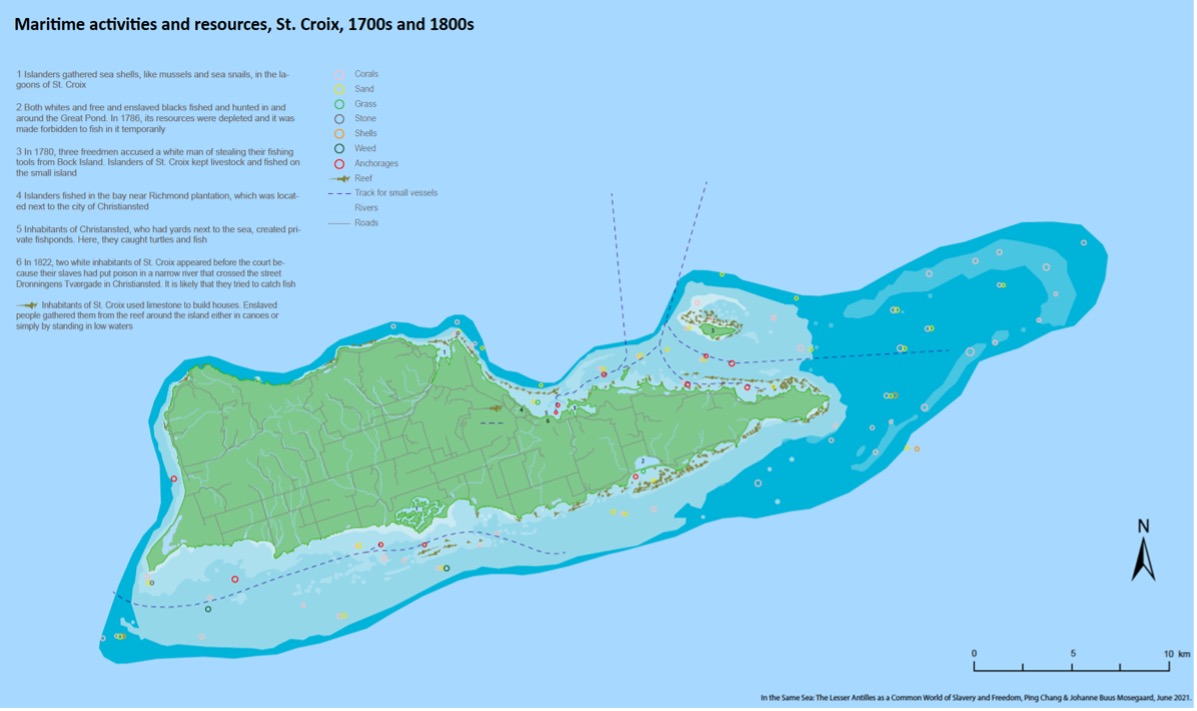
Colonial authorities also attempted to regulate enslaved people’s use of small boats and canoes. These efforts were made in order to prevent slaves from escaping the islands in fishing crafts. Such regulation was not easy to implement, however. Authorities knew that the free poor population depended on marine activities for a living and therefore a complete ban on the small craft was not a possibility.[27] Instead, boats were regulated in other ways. From 1742, everyone had to keep a fishing net in their boats, so authorities could make sure that it was used for fishing. In 1734 and again in 1756 it was ordered that every boat owner should provide a guarantee of being able to cover expenses for “the possible damages they [the boats] [could] cause.”[28] The order from 1734 was described by Høst as “extensive,” and his guess was that it must have caused a shortage of both fishermen and fish.[29]
White fear of enslaved people escaping in seaborn vessels was in many ways well-founded, as studies in maritime marronage show.[30] But that quite a lot of enslaved people fished for their masters suggests that many enslaved engaged with resources at sea without escaping. In a court case from 1823, it appears that a planter punished his enslaved fisher, John Farrier, for breaking their agreement. Farrier had been away on a fishing trip for three days, even though he was supposed to report to his master every second day.[31] The court case against John Farrier provides an example of the sort of arrangements slave masters could make to ensure that fishers would be successful in the exploitation of marine resources while still having control over them.
John Farrier’s story also suggests that running away was indeed a complex choice. Many factors need to be taken into consideration, such as the possibilities and risks of escaping, knowledge of viable destinations, and thoughts about the people that would be left behind. The position of a fisher or the possibility of going on small fishing trips was probably attractive to many enslaved men. To be entrusted with this position meant a relief from the heavy burden of field labour as well as time away from the master and plantation life. Furthermore, according to Oldendorp, enslaved people that could fish and steer a canoe or a bark enjoyed more respect than plantation slaves.[32] Whether such respect was also paid to the enslaved carpenter and fisherman Pedro in the early nineteenth is not clear. However, in 1807, Pedro apparently owned several slaves, whom he had bought from the money he had earned from selling provisions and fish. Though it was exceptional for an enslaved person to own slaves, it reveals that the position of fisher could offer opportunities that were rare for enslaved people.[33]
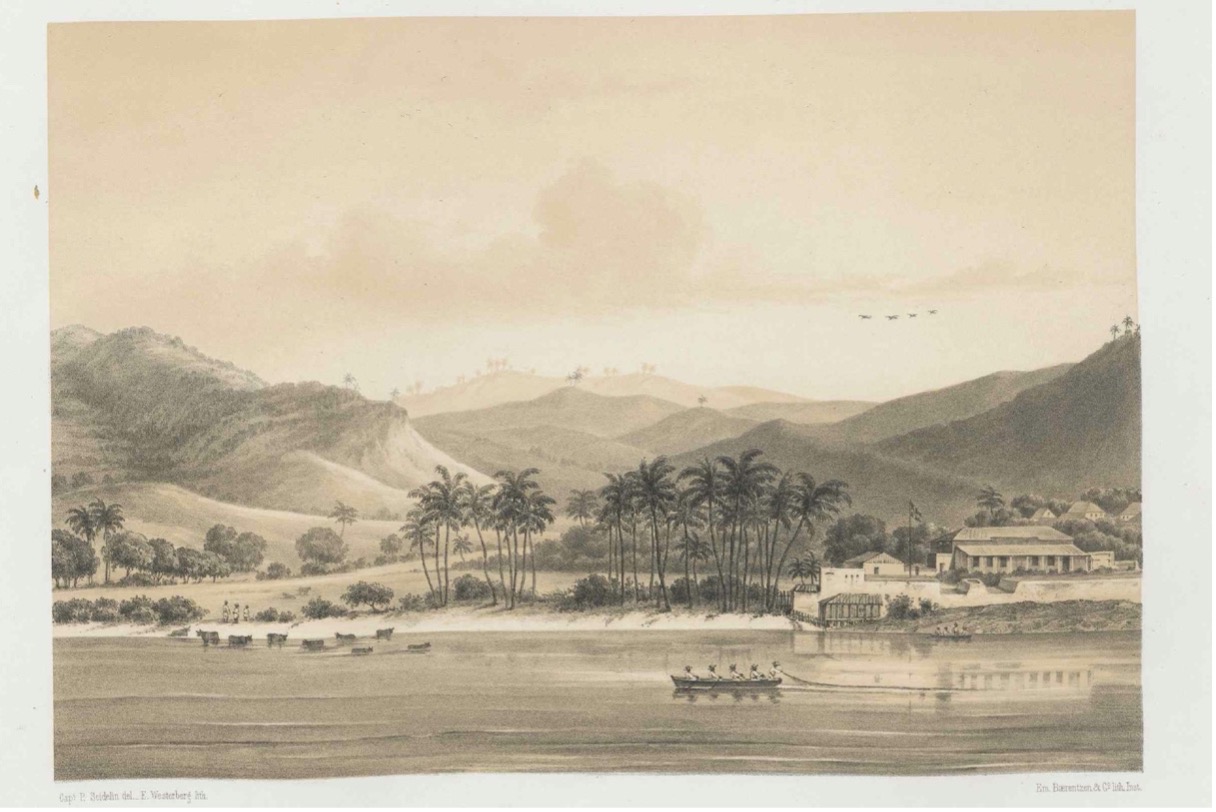
Although fishing might be a more attractive job than plantation labour, it was not without risks and danger. Poisonous plants could potentially be injured, both when fishing with them, but also just by being near them. There was also a risk of drowning, or even of being eaten by sharks, as was the case with a man whom Oldendorp knew.[34] Furthermore, those enslaved men whom masters trusted to fish had a more intimate relationship with their masters, which may have increased the likelihood of punishment.[35] This happened to the before-mentioned John Farrier whose master punished him by beating him with a rope, after which he was also punished by the estate driver.[36] This incident may have caused Farrier’s owner to degrade him from his position as a fisher, sending him back to the cane field. Much was at stake for men like Farrier. Not only fishing but also the consumption of fish and shells could be dangerous. The small sprats that enslaved people ate were poisonous at some points during the year, and according to Haagensen several slaves died after eating them.[37] Because of such possible dangers, knowledge of the waters, marine animals, and seasonal changes was crucial. Many slaves did indeed possess such skills and knowledge. William Ferguson, possibly a member of the British troops in the Caribbean, wrote that black fishermen knew where and when to fish to avoid poisonous fish, like the sprat.[38] The principal of the school for white children in Christiansted Hans West (1758-1811), who seldom saw anything positive in people of African descent, was clearly impressed by enslaved people’s knowledge of marine life, recording slaves’ ability to name – and thus identify – many species of fish.[39] Oldendorp also praised the marine skills of Africans, in particular those of the Amina nation whom he believed to be particularly skilled fishers. An impression that may also be sustained by the author of Carstens’ account who complained that Amina people would rather fish than grow crops.[40]
Despite the dangers and difficulties of fishing, enslaved people did seldom reap the best fruits of their hard labour. They would rarely eat the delicate and nutritious turtle meat, but instead mostly eat the small sprats and piskets, which were the humblest fishes. According to Oldendorp, these minnows were used to cook “callaloo” stew and boiled for soup.[41] Oldendorp realized that the enslaved population had difficulties satisfying their nutritional needs. According to him, the most important provisions were grown on the enslaved people’s own plots of land, but they would rarely have time to cultivate them. Instead, on Saturday nights, they would go to the sea to catch fish, crayfish, and shellfish, and they would collect crabs on land.[42] Some enslaved people also resorted to theft, like Mingo who was in court for stealing fish in 1769, or Sam and Joe who were accused of stealing two fish traps in 1824. It was a struggle for enslaved Africans in the Danish West Indies to get full every day.
The struggle for food
In historical research, there has traditionally been a tendency to focus on the Caribbean colonies’ dependency on imported goods from Europe and North America, but this does not give a comprehensive picture of the challenges faced by islanders.[43] As a response, scholars have emphasized the importance of provision grounds and the independent food production of enslaved peoples as well as their reliance on and use of natural resources.[44] Caribbean societies were dependent on both productions of provisions on plantations, on enslaved people’s own grounds and on the food they could get from the surrounding nature – in addition to imported goods from Europe and North America. Living in fragile societies, shaped by both overexploitation of resources and overpopulation, islanders could not only rely on their own agricultural production. Seasonal changes and natural phenomena, like hurricanes and droughts, were recurring problems, that could possibly ruin the crops. Though islanders could get food from different sources, the everyday lives of enslaved and possibly also of poor white people and free people of colour in the Danish West Indies were affected by the fact that they had to struggle to find food enough to satisfy their nutritional needs.[45]
Enslaved Africans found it particularly difficult to fulfil their needs. Though seasonal changes and temporal and geographical variables should be taken into consideration, historian Niklas Thode Jensen has shown that the enslaved were malnourished, for at least part of the year. Indeed, the nutritive value of fish and other resources from the surrounding nature was crucial for the survival of Caribbean islanders, especially enslaved people, who could not buy imported goods to the same extent as the white and wealthier population. Again, according to Thode Jensen, the vitamins and minerals in natural resources were able to meet the daily needs of an adult enslaved person, yet it is difficult to determine how many enslaved people actually had access to enough of these resources. While Thode Jensen notes that such natural resources were always only a supplement to food rations issued by estate managers and the crops enslaved people grew, the detailed mapping of the role of fish provided here suggests that such marine resources may have been more important than we have hitherto acknowledged.[46]
Islanders exploited these resources in organized ways from the beginning of Danish colonial settlement and probably even from early settlements. Authorities knew that the population needed seafood, especially in difficult times, like after hurricanes. The importance of marine resources also turned them into objects of regulation. Danish colonial authorities were particularly concerned with controlling the actions, mobility, and financial opportunities of enslaved Africans and free people of colour, but efforts were also made to conserve natural resources. While authorities stated that a decrease in any food source would harm the public in general, it was, in particular, the enslaved part of the population that would be harmed by any reduction in food supplies.[47]
Reliance on and exploitation of marine resources was not only a Danish West Indian phenomenon. Other islands in the Lesser Antilles faced the same challenges, and local authorities had similar responses to them. In 1819, Ferguson wrote that “the British troops, under the scarcity of fresh provisions, always depended much on the sea for subsistence.”[48] In the British Empire, ordinances that controlled the use of poison and the size of meshes in fishing nets were issued, and they too were concerned with enslaved people’s use of boats.[49] But islanders in the Lesser Antilles kept on searching for natural resources in waterscapes, on unsettled islands and small cays, at shorelines, in rivers and ponds, and they created various local foodways. In this search, entanglements and sometimes clashes between imperial powers could not be avoided – such as those that emerged when goods were imported from Puerto Rico, both legally and illegally, or when Danish West Indian fishers settled secretly on Crab Island without the knowledge of the Spanish authorities and Spanish ships chased after them if they found out.[50] Fishing and the struggle over marine resources, while always important, became central as island societies moved towards harder exploitation of land resources. This struggle is part of the story of how the Lesser Antilles became an integrated economic space that was both complex, creative, and partly self-sufficient.[51]
Notes:
[1] Oldendorp, C. G. A. Historie der Caribischen Inseln Sanct Thomas, Sanct Crux und Sanct Jan: Insbesondere der Dasigen Neger und der Mission der Evangelischen Brüder unter Denselben. Zweiter Teil/2. Berlin: VWB, Verlag für Wissenschaft und Bildung, 2002 (orig. 1777), 1160.
[2] Highfield, Arnold R. Sainte Croix, 1650-1733: A Plantation Society in the French Antilles. Christiansted, St. Croix: Antilles Press, 2013, 112.
[3] Haagensen, Johan Reimart. Beskrivelser over Eylandet St. Croix i America i Vest-Indien. København: L. H. Lillies Enke, 1758, 68; Oldendorp, C. G. A. Historie der Caribischen Inseln Sanct Thomas, Sanct Crux und Sanct Jan: Insbesondere der Dasigen Neger und der Mission der Evangelischen Brüder unter Denselben. Erster Teil. Berlin: VWB, Verlag für Wissenschaft und Bildung, 2000 (orig. 1777), 111; West, Hans. Beretning om det danske Eiland St. Croix i Vestindien, fra Junii Maaned 1789 til Junii Maaned Udgang 1790. København, 1790, 9.
[4] Carstens, J. L. En Almindelig Beskrivelse om alle de Danske, Americanske eller West-Jndiske Ey-Lande. Dansk Vestindien for 250 år siden. København: Dansk vestindisk forlag, 1981 (orig. c. 1740), 69.
[5] Haagensen, Beskrivelser over Eylandet St. Croix, 21.
[6] Danish National Archives: The West Indian Local Archives, Christiansted byfoged, 38.6.28. Domprotokoller [for bytinget], case, 1819-11-13.
[7] Danish National Archives: The West Indian Local Archives, Generalguvernementet, 2.1.4. Plakatbøger, 1786-03-31.
[8] "Negerspeisen" in the original. Oldendorp, Historie der Caribischen Inseln, Erster Teil, 341; [viii] Oldendorp, C. G. A. Historie der Caribischen Inseln Sanct Thomas, Sanct Crux und Sanct Jan: Insbesondere der Dasigen Neger und der Mission der Evangelischen Brüder unter Denselben. Zweiter Teil/1. Berlin: VWB, Verlag für Wissenschaft und Bildung, 2002 (orig. 1777), 60ff.
[9] Danish National Archives: The West Indian Local Archives, Christiansted byfoged, 38.9.04. Politiretsprotokoller, 1780-12-18; and Danish National Archives: The West Indian Local Archives, Christiansted byfoged 38.9.18. Politiretsprotokoller, 1820-09-27.
[10] Haagensen, Beskrivelser over Eylandet St. Croix, 70ff.
[11] Haagensen, Beskrivelser over Eylandet St. Croix, 72; Oldendorp, Historie der Caribischen Inseln, Erster Teil, 608; Carstens, En Almindelig Beskrivelse, 20.
[12] Carstens, En Almindelig Beskrivelse, 19; Oldendorp, Historie der Caribischen Inseln, Erster Teil, 38.
[13] Sommer, Søren. “En kort beskrivelse om Skt. Thomas og Skt. Croix udi Vestindien.” Dansk Vestindisk Selskab 21, no. 1 (January 1986) (orig.1738): 12–21, 16.
[14] Oldendorp, Historie der Caribischen Inseln, Erster Teil, 537; Nissen, Johan Peter. Reminiscences of a 46 years’ residence in the island of St. Thomas in The West Indies. Nazareth, Pennsylvania: Senseman & Co., 1838, 87.
[15] Danish National Archives: The West Indian Local Archives, Vestindisk-Guineisk Kompagni, Guvernementet for St. Thomas og St. Jan. 446. Plakatbøger fra St. Thomas, 1728-08-21.
[16] Høst, Georg. Efterretninger Om Øen Sanct Thomas Og Dens Gouverneurer, Optegnede Der Paa Landet Fra 1769 Indtil 1776. København: Nicolaus Møller og Søn, 1791, 83.
[17] Danish National Archives: The West Indian Local Archives, Christiansted byfoged, 38.9.05. Politiretsprotokoller, 1782-06-14.
[18] Jensen, Niklas Thode. For the health of the enslaved: slaves, medicine and power in the Danish West Indies, 1803-1848. Copenhagen: Museum Tusculanum Press, University of Copenhagen, 2012., 181ff.
[19] Carstens, En Almindelig Beskrivelse, 18, 30, 43; Haagensen, Beskrivelser over Eylandet St. Croix, 68f; [xix] Oldendorp, C. G. A. Historie der Caribischen Inseln Sanct Thomas, Sanct Crux und Sanct Jan: Insbesondere der Dasigen Neger und der Mission der Evangelischen Brüder unter Denselben. Zweiter Teil/3. Berlin: VWB, Verlag für Wissenschaft und Bildung, 2002 (orig. 1777), 1669; McKinnen, Daniel. Tour Through the British West Indies, in the Years 1802 and 1803, Giving a Particular Account of the Bahama Islands. London: J. White, 1803, 5; Danish Royal Library: Håndskriftssamlingen. NKS 766. Anton Claussen, Eigenhændige Nachricht v. dänischen Eiland St. Croix in America, St. Croix, 1777, §9.
[20] Carstens, En Almindelig Beskrivelse, 88f; Oldendorp, Historie der Caribischen Inseln, Zweiter Teil/3, 1633.
[21] Danish National Archives: The West Indian Local Archives, Generalguvernementet, 2.1.7. Plakatbøger, 1794-07-18.
[22] Danish National Archives: The West Indian Local Archives, Vestindisk-Guineisk Kompagni, Direktionen. 446. Ældre koloniale plakater, bekendtgørelser og befalinger for St. Thomas og St. Jan. 1700-08-19; Danish National Archives: The West Indian Local Archives, Generalguvernementet, 2.1.1. Plakatbøger, 1771-04-30; Danish National Archives: The West Indian Local Archives, Generalguvernementet, 2.1.4. Plakatbøger, 1786-03-31.
[23] Danish National Archives: The West Indian Local Archives, Generalguvernementet, 2.1.1. Plakatbøger, 1771-04-30; Danish National Archives: The West Indian Local Archives, Generalguvernementet, 2.1.4. Plakatbøger, 1786-03-31.
[24] Danish National Archives: The West Indian Local Archives, Generalguvernementet, 2.1.1. Plakatbøger, 1771-04-30.
[25] Danish National Archives: The West Indian Local Archives, Generalguvernementet, 2.1.4. Plakatbøger, 1786-03-31.
[26] Danish National Archives: The West Indian Local Archives, Generalguvernementet, 2.1.1. Plakatbøger, 1772-09-02.
[27] Danish National Archives: The West Indian Local Archives, Vestindisk-Guineisk Kompagni, Direktionen. 442. Ældre koloniale plakater, bekendtgørelser og befalinger for St. Thomas og St. Jan. 1737-11-30.
[28] Danish National Archives: The West Indian Local Archives, Generalguvernementet, 2.1.1. Plakatbøger, 1742-02-13; Danish National Archives: The West Indian Local Archives, Generalguvernementet, 2.1.1. Plakatbøger, 1756-05-17; Danish National Archives: The West Indian Local Archives, Vestindisk-Guineisk Kompagni, Direktionen. 365. Samlinger af skrevne love for øen St. Thomas. 1734-08-22.
[29] Høst, Efterretninger Om Øen Sanct Thomas, 123.
[30] Hall, Neville A. T. Slave Societies in Danish West Indies. Edited by B. W. Higman. Kingston: University of the West Indies Press, 1994, 124ff.
[31] Danish National Archives: The West Indian Local Archives, Christiansted byfoged, 38.6.29. Domprotokoller [for bytinget], verdict 1823-09-27.
[32] Oldendorp, Historie der Caribischen Inseln, Erster Teil, 548.
[33] Danish National Archives: The West Indian Local Archives, Christiansted byfoged, 38.9.14. Politiretsprotokoller, 1807-12-16.
[34] Oldendorp, Historie der Caribischen Inseln, Erster Teil, 316; Oldendorp, Historie der Caribischen Inseln, Zweiter Teil/2, 1349.
[35] Burnard, Trevor G. Mastery, Tyranny, and Desire: Thomas Thistlewood and His Slaves in the Anglo-Jamaican World. Chapel Hill: University of North Carolina Press, 2004, 193, 198
[36] Danish National Archives: The West Indian Local Archives, Christiansted byfoged, 38.6.29. Domprotokoller [for bytinget], verdict 1823-09-27.
[37] Haagensen, Beskrivelser over Eylandet St. Croix, 69.
[38] Ferguson, William. On the Poisonous Fishes of the Caribbee Islands. Edinburgh: P. Neill, 1819, 5.
[39] West, Beretning om det danske Eiland St. Croix, 43.
[40] Oldendorp, Historie der Caribischen Inseln, Erster Teil, 668; Carstens, En Almindelig Beskrivelse, 84.
[41] Oldendorp, Historie der Caribischen Inseln, Erster Teil, 536ff.
[42] Oldendorp, Historie der Caribischen Inseln, Erster Teil, 536.
[43] See for instance Sheridan, Richard B.. Sugar and Slavery: An Economic History of the British West Indies, 1623-1775. Barbados: Caribbean Universities Press, 1974; Galloway, J. H. The Sugar Cane Industry: An Historical Geography from its Origins to 1914. Cambridge: Cambridge University Press, 1989; Tomich, Dale W. Slavery in the Circuit of Sugar: Martinique and the World Economy, 1830-1848. Baltimore: Johns Hopkins University Press, 1990; Klooster, Wim. Illicit Riches: Dutch Trade in the Caribbean, 1648-1795. Leiden: KITLV, 1998.
[44] See for instance Jensen, Niklas Thode. For the health of the enslaved: slaves, medicine and power in the Danish West Indies, 1803-1848. Copenhagen: Museum Tusculanum Press, University of Copenhagen, 2012; Higman, B. W. A Concise History of The Caribbean. New York: Cambridge University Press; Olwig, Karen Fog. Cultural Adaptation and Resistance on St. John. Gainesville: University of Florida Press.
[45] Jensen, For the Health of the Enslaved, 153.
[46] Jensen, For the Health of the Enslaved, 186ff.
[47] Danish National Archives: The West Indian Local Archives, Generalguvernementet, 2.1.4. Plakatbøger, 1786-03-31.
[48] Ferguson, On the Poisonous Fishes, 2.
[49] E.g., The Laws of the island of Antigua; consisting of the acts of the Leeward Islands, commencing 8th November 1690, ending 21st April 1798; and the acts of Antigua, commencing 10th April 1668, ending 7th May 1804. London: Samuel Bagster, 1850, 335 (1756-11-18); Laws of the Island of St. Christopher; From the Year 1711 to the Year 1791. Saint Christopher’s: Edward Luther Low, 1791, 102 (1750-09-11); Montserrat Code of Laws: From 1668 to 1788. London: Robert Hindmarsh, 1790, 40 (1722); Acts of Assembly, Passed in the Island of Nevis, From 1664 to 1739, inclusive. London: John Baskett, 1740, 133 (1737).
[50] West, Beretning om det danske Eiland St. Croix, 9; Høst, Efterretninger Om Øen Sanct Thomas, 134; Nissen, Reminiscences of a 46 years’ residence, 50; Oldendorp, Historie der caribischen Inseln Sanct Thomas, Sanct Crux und Sanct Jan, Erster Teil, 38.
[51] Draper, Mary. “Timbering and Turtling: The Maritime Hinterlands of Early Modern British Caribbean Cities.” Early American Studies: An Interdisciplinary Journal 15, no. 4 (2017): 769–800. https://doi.org/10.1353/eam.2017.0028, 770, 798ff.
